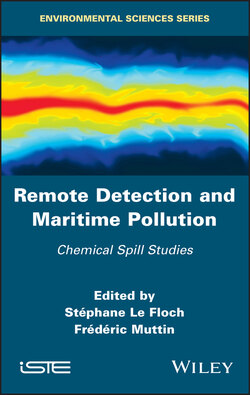Читать книгу Remote Detection and Maritime Pollution - Группа авторов - Страница 21
1.3.2.2. Experimental releases
ОглавлениеHNS releases were planned to be performed two at a time, i.e. two HNS were nearly simultaneously released and imaged by the aircraft. The most dangerous HNS were first released (heptane and toluene), then methanol and xylene for the second release and, finally, FAME and rapeseed oil for the third release.
Table 1.1. Environmental conditions
| Date | Time (UTC) | Wind speed (m/s) | Wind direction (from-deg) | Wave height (m) | Wave direction (from-deg) |
| May 18, 2015 | 17:00 | 8 | 255 | 0.5 | 240 |
| May22, 2015 | 13:00 | 7 | 315 | 2 | 270 |
| May 22, 2015 | 16:00 | 7 | 315 | 1.75 | 270 |
The methodology used to release HNS is ideally suited to good weather conditions and, in particular, for a sea state compatible with the lifting operations. The first release was performed as planned on May 18 thanks to good weather conditions. Then, a strong wind episode (May 19–21, force 8, 35–40 knots) forced us to replan the last two releases on May 22. Sea and weather conditions during the experimentation are described in Table 1.1.
The first release took place on May 18, from 16:40 to 17:30 UTC. The sea was calm. Heptane and toluene were released from two semi-submersible 1 m3 tanks at 16:30 and 16:35 UTC, respectively (Figure 1.3). Heptane and toluene were released at a fixed position (separated by about 100 m). No samplings were realized for this release due to the reactivity of these HNS. Two drifting buoys were deployed simultaneously with the releases.
The airborne sensors implemented for this release were:
– SETHI: radar (X + L quad-pol) and optical (SWIR) sensors;
– DGDDI: SLAR and IR/UV.
Figure 1.3. Releases of heptane and toluene
The positions of the two drifting buoys and the tanks at their opening and their recovery are shown in Figure 1.4. Buoys and tank data show a WSW direction drift. Toluene and heptane are highly volatile chemicals, and their persistence at sea surface is limited (prediction of 30 minutes persistence with the software CHEMAP). However, drifting buoys are of interest during such experiments to obtain in situ information, which enables us to readjust the prediction models.
The second release took place on May 22, from 13:25 to 13:55 UTC. There was a heavy swell, restricting any activity at sea; hence, products were discharged directly from the back of the vessel (French Navy) advancing towards the east at a speed of 1 knot: methanol was released from 12:35 to 12:45 UTC and xylene from 12:55 to 13:25 UTC. The sea state made it impossible to use the dinghy, to deploy the drifting buoys or to sample the slick and water column.
Figure 1.4. Map of sea surface of tank and drifting buoy positions during the first release. For a color version of the figure, see www.iste.co.uk/lefloch/remote.zip
The airborne sensors implemented for this release were:
– SETHI: radar (X + L quad-pol) and optical (SWIR) sensors;
– DGDDI: SLAR and IR/UV;
– DRDC: LWIR hyperspectral.
The third release took place on May 22, from 15:20 to 16:50 UTC. Because of the swell, products were also released directly from the back of the boat advancing towards the east at a speed of 1 knot: rapeseed oil was discharged from 15:00 to 15:30 UTC and FAME from 15:25 to 15:40 UTC (Figure 1.5). No samplings and no deployment of drifting buoys were possible due to the sea state.
The airborne sensors implemented for this release were:
– SETHI: radar (X + L quad-pol) and optical (SWIR) sensors;
– DGDDI: SLAR and IR/UV;
– DRDC: LWIR hyperspectral.
Figure 1.5. Releases from on board the Ailette (a) and rapeseed oil slick (b)
